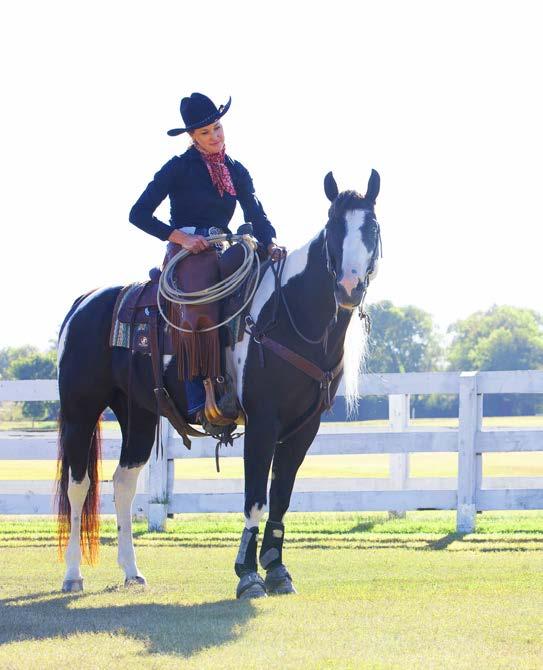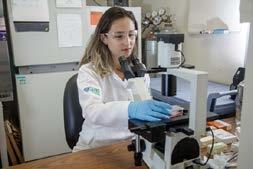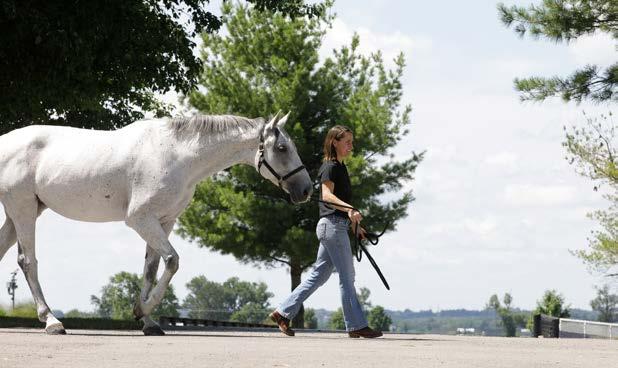Spotlight HORSE HEALTH



How the Merck Animal Health Equine Biosurveillance Program is shaping the fight against infectious pathogens.
As spring approaches and travel season ramps up, so does the spread of equine respiratory disease. When an infectious outbreak threatens horses in your area, it’s crucial that local veterinarians diagnose it ASAP to protect your horse and others. Enter the Merck Animal Health Equine Biosurveillance Program . The industry is stepping up to support equine veterinarians.
What is the Merck Animal Health Equine Biosurveillance Program?
You may know Merck Animal Health as the creator of premier products that keep your horse healthy, such as the PRESTIGE® line of equine vaccines. But the company is also invested in a number of efforts that demonstrate its Unconditional commitment to do what’s right for horses as well as the people who care for them.
Since 2008, Merck Animal Health has partnered with the University of California, Davis, School of Veterinary Medicine on the Equine Biosurveillance Program, a voluntary project in which veterinarians and researchers collaborate to monitor equine respiratory disease in horses nationwide. The program monitors four main pathogens:
• Equine herpesvirus types 1 and 4 (EHV-1, EHV-4): These respiratory viruses cause symptoms ranging from mild to severe; EHV-1 can also cause late-term abortions, early foal death and neurologic disease.
• Equine influenza virus (EIV): This highly contagious “flu” virus can cause fever, coughing, nasal discharge and lethargy.
• Streptococcus equi subspecies equi (S. equi or strangles): S. equi is a bacterium that causes strangles, a highly contagious disease that produces abscesses in the lymph nodes of the head and neck, as well as fever and nasal discharge.
• Equine rhinitis A/B viruses (ERAV/ERBV): These viruses infect horses’ respiratory tracts, with symptoms including fever, nasal discharge and coughing.
At the heart of the Equine Biosurveillance Program lies a commitment to four main goals:
1. Help equine veterinarians diagnose and treat infectious respiratory diseases as quickly as possible.
2. Help the horse industry understand how common these respiratory pathogens are, how they spread, and why they affect some horses more than others.
3. Identify and monitor the latest pathogen strains currently circulating.
4. Evaluate how well current vaccination protocols are working.

How does the program impact me and my horse?
If your horse contracts a respiratory disease, it’s important that your veterinarian diagnose it quickly and start appropriate treatment, and that you work together to prevent the spread of the disease to other horses in the area. But because many upper respiratory diseases share similar signs and symptoms (see “Top Respiratory Pathogen Symptoms”), this can be a challenge.
That’s why the program provides tools to help veterinarians collect nasal swab samples from horses quickly and efficiently, submit them for evaluation by a qualified laboratory, and arrive at a diagnosis quickly—so they can create the best treatment plan for their patients.
If your veterinarian is a participant in the Biosurveillance Program, he or she receive results within 24 to 36 hours of submitting a sample, along with expert input to help treat the patient effectively. This quick turnaround gives your veterinarian an excellent chance to not just manage individual cases but shut down potential outbreaks successfully.
To be included in the Merck Animal Health Biosurveillance Program, a sample must come from a horse with a fever of at least 101.5° F. Other symptoms often include:
• Nasal discharge
• Coughing
• Lethargy
• Appetite loss
• Central nervous system problems
These signs of disease are more or less common depending on the infectious organism causing them, but they are prevalent across equine respiratory illnesses.
By working with veterinarians to collect samples in this way, the Biosurveillance Program has amassed the largest collection of equine infectious upper respiratory data in the United States. To date, nearly 12,000 samples have been submitted from veterinarians across the United States from horses of all ages, sexes and breeds. This extensive dataset has proved pivotal for advancing horse health care to date and will only boost equine health outcomes in the future.
A key finding of the Biosurveillance Program has been the identification of EHV-4 and EIV as the most common upper respiratory pathogens affecting horses. These viruses have made up the largest proportion of positive sample results in the past 16 years. However, the program has also been tracking an uptick in S. equi in the past two years, making it the most prevalent pathogen tested in 2023.
The Biosurveillance Program also tracks the time of year when pathogens are most prevalent (see “Respiratory Disease Incidence in 2023”), which helps veterinarians figure out the best times to vaccinate—as well as what measures will help keep disease from spreading among horses. The fact is, vaccination alone isn’t enough to provide complete protection, especially for highly contagious diseases like
equine herpesvirus, influenza and S. equi. For the highest level of protection, horse owners and handlers must follow sound biosecurity practices to provide a broader net of disease protection.
Another significant contribution of the Biosurveillance Program has been the identification and isolation of Florida ’13. This highly pathogenic strain of influenza is considered the most current, clinically significant strain and is available only in Merck Animal Health’s PRESTIGE® vaccines.
Several scientific publications and presentations have been generated from the data to educate the larger equine community. Participating veterinarians receive updates from the data twice yearly to guide their practice decisions and provide timely updates for horse owners.
The Merck Animal Health Equine Biosurveillance Program is all part of the company’s Unconditional commitment to horses and the people who love and care for them. As you can see, that commitment goes far beyond developing innovative equine health products. It also powers some of the most innovative research programs impacting the equine industry today.
Equine respiratory disease waxes and wanes throughout the year, as do the individual organisms causing illness. While S. equi was the most common pathogen detected each month in 2023, EIV, EHV-4 and ERBV were often not far behind.

At the Gluck Equine Research Center at the University of Kentucky, Izabela De Assis Rocha, BVM, a PhD candidate and research fellow, is making significant progress in the study of equine protozoal myeloencephalitis (EPM), a neurological disease caused by the parasite Sarcocystis neurona
Supported by the Merck Animal Health Equine Research Fellowship, Dr. Rocha’s work is not just advancing our understanding of EPM but also nurturing the next generation of scientists dedicated to equine health. “Merck Animal Health’s partnership with the Gluck Equine Research Center has been instrumental in providing resources for training a new generation of scientists,” Dr. Rocha says. “It’s an incredible opportunity to share novel research findings with equine practitioners who frequently work on EPM cases.”
Dr. Rocha’s research focuses on understanding how the antiprotozoal drug diclazuril (manufactured by Merck Animal Health as Protazil® [1.56% diclazuril] Antiprotozoal Pellets) works against S. neurona. She has identified a transporter molecule in the parasite that’s targeted by the drug, which is exciting because it shows that diclazuril affects a pathway unique
to the parasite, making it both specific and safe for use in horses.
One of the findings Dr. Rocha has been surprised by is the fact that diclazuril can stop parasite growth in cell culture at very low concentrations. So why does treating horses with EPM remain challenging, with a success rate of 60-70%? “This may be related to the chronic and inflammatory aspects of the disease rather than the antiprotozoal efficacy,” Dr. Rocha explains.
She plans to expand her research to investigate inflammation in the central nervous system of horses with EPM to develop additional treatment approaches. “As with all research, there is always more to do,” she says.
is contraindicated in horses with known hypersensitivity to diclazuril. The safety of Protazil in horses used for breeding purposes, during pregnancy, or in lactating mares, and use with concomitant therapies in horses has not been evaluated. Do not use in horses intended for human consumption. Not for human use. For complete safety information, refer to the product label.
It’s clear from Dr. Rocha’s work that Merck Animal Health focuses not just on creating horse health products, but also on investing in young talent who are making a difference in the future of equine health. In fact, part of the company’s Unconditional promise to do the right thing for horses is providing research grants that can shape the future of equine veterinary medicine.
For horse owners, this means better treatments and understanding of diseases like EPM. Thanks to the efforts of scientists like Dr. Rocha and the support of companies like Merck Animal Health, the future of equine health is brighter than ever.
Izabela De Assis Rocha, BVM, PhD candidate, is studying EPM At the Gluck Equine Research Center in Kentucky with the support of a research grant from Merck Animal Health.

EPM is a relatively rare disease that horses can develop after ingesting opossum feces containing the S. neurona parasite. Owners who are aware of the condition can act quickly to alert their veterinarian if their horse shows clinical signs and begin the diagnosis and treatment process. Early detection and management can lessen the severity of the disease and improve outcomes for affected horses. Click below to learn more.

If you’re confronting an equine disease outbreak, immediate action is vital in order to protect other horses from infection. Here are a few biosecurity measures you can implement to minimize the transmission of pathogens on your farm during an infectious disease outbreak.
Contact your veterinarian immediately.
The first thing you should do when a horse is showing signs of infection is request a visit from your veterinarian as soon as possible. He or she is the best resource to help you navigate an infectious disease outbreak on your farm and can help you develop an effective biosecurity plan.
Halt all incoming and outgoing equine traffic at your facility.
Whether you’re dealing with an upper respiratory or a gastrointestinal outbreak, stop all movement of horses in and out of your facility. Wait until you’re able to get a veterinarian on site to assess the infected horse(s) and help you understand and manage the situation before resuming normal activities.
Isolate the infected horse to minimize contact risks.
If you think you have a sick horse on your property, move it away from your other horses immediately. If you don’t have a separate quarantine barn or isolation stall, relocate the infected horse to the end of the barn aisle and minimize the number of people and horses coming into contact with it.
Manage the infected horse(s) last.
To help minimize exposure, work with healthy horses first and wait to handle any infected horses until the end of the day when you’re sure you won’t be in contact with any healthy horses. Infected horses should also have their own equipment (halter, lead rope, buckets and so on) that’s only used on them to ensure limited pathogen transmission.
The best defense against an infectious disease outbreak is to equip yourself with knowledge and tools. By taking action immediately, consulting your veterinarian and taking these simple steps, you can stem the spread of infection and safeguard the health of every horse on your farm.

Dr. Cara Wright, a graduate of the Virginia-Maryland Regional College of Veterinary Medicine, brings her passion for equine health and a background in private practice to her work at Merck Animal Health. Having worked extensively with equine athletes, she understands the needs of working horses and has utilized alternative modalities to keep them performing at their peak. Outside of work, Dr. Wright enjoys international travel and competing in triathlons.
We’ve got more answers! Visit the Merck Animal Health Facebook page to find more expert veterinary advice for horse owners.
Equine herpesvirus type 4 (EHV-4), the most common infectious upper respiratory disease in horses,1 is a tricky virus. A horse can be infected without showing signs of disease, making EHV-4 highly contagious and even endemic in some herds. Find out more so you and your veterinarian can combat EHV-4 in your own horses.
• EHV-4 is a highly contagious respiratory disease that can cause signs ranging from mild to severe.
• It is spread via coughing horses, direct and indirect contact, and nasal secretions.
• It typically occurs in younger horses but can affect horses of any age.
• Horses exposed to the virus at a younger age may become carriers for life. Stress may reactivate the disease later in life.
• Virus shedding can occur silently (without clinical signs) and last for more than 10 days. After exposure, the incubation period may be as short as 24 hours but is typically four to six days or longer.
• Fever (102° to 107°F)
• Nose and eye discharge
• Lethargy
• Loss of appetite
Diagnosis is often performed with a nasal swab that is submitted to a laboratory for polymerase-chain reaction (PCR) testing.
• EHV-4 typically peaks from October to February, but can occur any time of year1
• These horses at risk should be revaccinated at six-month intervals:2
• Horses that travel and are in frequent contact with large numbers of horses
• Horses at home exposed to traveling horses
• Horses with compromised or immature immune systems
• Benefits of vaccination:
• Reduced risk of infection
• Reduced shedding of virus by infected horses so less virus circulating in the horse population
• Reduced severity of clinical signs
• Less time off exercise, training and competing
• Lower cost of veterinary treatment
• Supportive care and rest are key. Nonsteroidal anti-inflammatory products may be prescribed by your veterinarian.
• Recovery depends on severity of disease.
1Merck Animal Health and University of California, Davis (Nicola Pusterla, DVM). Infectious Upper Respiratory Disease Surveillance Program. Ongoing research 2008-present.
2AAEP Risk-Based Vaccination Guidelines (www.aaep.org)
1. EHV-4 is highly contagious and spreads rapidly.
2. Avoid nose-to-nose contact with other horses.
3. Isolate all new entries or horses returning to the stable from travel.
4. Check temperatures at least once and preferably twice daily (Normal = 99°F – 101°F).
5. Isolate any horse with elevated temperature and/or occurrence of unprovoked coughing.
6. Do not share tack, water buckets, feed sources, etc.
7. Practice good hand hygiene (hand sanitizers in absence of soap and water).
8. Clean and disinfect hauling equipment like trailers after each use.
9. Contact your veterinarian immediately to schedule a comprehensive examination.
Copyright © 2024 Merck & Co., Inc., Rahway, NJ, USA and its affiliates. All rights reserved. US-NON-240300031